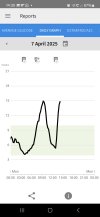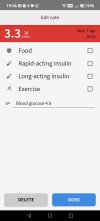Hi, I am newly diagnosed type 1 and started insulin last Thursday. The specialist nurse decided to start me on a low dose of mixed fast and slow Humulin, 10 units, before breakfast and before dinner. She suggested I would need to increase by 2 afyer 2-3 days until I reached the right level. I speak to her again in a week or so.
My libre is alerting me to low blood sugar overnight at 4.4 (the nurse set it a bit higher to give me chance to address the low before I'm having a hypo, without having to resort to a load of glucose). So I have had a seeded oat cake in the night and that seems to work ok but getting woken up is not ideal. However I am then getting high levels on a morning. Today it was 8ish about half an hour after getting up which isn't so bad.I took the insulin then but by the time I started breakfast 30 mins later it was 11ish, then peaked at 15 ish an hour or so after breakfast. Its currently coming back down and I will probably have to snack to head off a low in an hour or so. The nurse told me I must have carbs with my meals, so today I had 2 boiled eggs, half an avocado, some feta and a smallish slice of buttered sourdough toast.
I don't feel I should be increasing my insulin as I am getting lows, but how do I stop the highs? I had potato with my dinner last night and that was ok, I didn't spike. Should I just avoid bread? Or perhaps have the bread an hour after breakfast (1.5 hrs since the insulin) to give that a chance to kick in? I'm worried without carbs I'll go low.
And what can I eat on an evening to stop the overnight lows?
Am I better off grazing throughout the day rather than having 3 meals? The humulin brochure suggested 4 meals so yesterday I had yoghurt, nuts, seeds, banana and strawberry before bed to see if that would stop the low but it didn't.
Has anyone got any tips to stop the morning and post meal highs , and to stop the lows? Yesterday lunchtime I started to go v low so grabbed some sushi. That was a bad idea - I went sky high so I guess sushi is off the menu!
Any help greatly appreciated. Thanks
My libre is alerting me to low blood sugar overnight at 4.4 (the nurse set it a bit higher to give me chance to address the low before I'm having a hypo, without having to resort to a load of glucose). So I have had a seeded oat cake in the night and that seems to work ok but getting woken up is not ideal. However I am then getting high levels on a morning. Today it was 8ish about half an hour after getting up which isn't so bad.I took the insulin then but by the time I started breakfast 30 mins later it was 11ish, then peaked at 15 ish an hour or so after breakfast. Its currently coming back down and I will probably have to snack to head off a low in an hour or so. The nurse told me I must have carbs with my meals, so today I had 2 boiled eggs, half an avocado, some feta and a smallish slice of buttered sourdough toast.
I don't feel I should be increasing my insulin as I am getting lows, but how do I stop the highs? I had potato with my dinner last night and that was ok, I didn't spike. Should I just avoid bread? Or perhaps have the bread an hour after breakfast (1.5 hrs since the insulin) to give that a chance to kick in? I'm worried without carbs I'll go low.
And what can I eat on an evening to stop the overnight lows?
Am I better off grazing throughout the day rather than having 3 meals? The humulin brochure suggested 4 meals so yesterday I had yoghurt, nuts, seeds, banana and strawberry before bed to see if that would stop the low but it didn't.
Has anyone got any tips to stop the morning and post meal highs , and to stop the lows? Yesterday lunchtime I started to go v low so grabbed some sushi. That was a bad idea - I went sky high so I guess sushi is off the menu!
Any help greatly appreciated. Thanks



